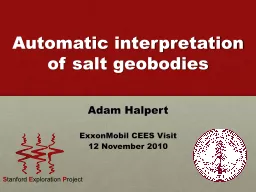

geobodies Adam Halpert ExxonMobil CEES Visit 12 November 2010 S tanford E xploration P roject Why automate Save time Manual saltpicking is tedious timeconsuming Major bottleneck for iterative imagingmodelbuilding ID: 583731
Download Presentation The PPT/PDF document "Automatic interpretation of salt" is the property of its rightful owner. Permission is granted to download and print the materials on this web site for personal, non-commercial use only, and to display it on your personal computer provided you do not modify the materials and that you retain all copyright notices contained in the materials. By downloading content from our website, you accept the terms of this agreement.
Slide1
Automatic interpretation of salt geobodies
Adam HalpertExxonMobil CEES Visit12 November 2010
S
tanford
E
xploration
P
rojectSlide2
Why automate?Save time
Manual salt-picking is tedious, time-consumingMajor bottleneck for iterative imaging/model-buildingMaximize expertiseAllow experienced interpreters to focus on more complex geological problemsImprove health?Manual picking contributes to ergonomic strainSlide3
Automation strategies
“Traditional” horizon auto-trackersSlide4
Example imageSlide5
Auto-tracking
SEED POINTSSlide6
Auto-trackingSlide7
Auto-tracking
SEED POINTSSlide8
Auto-trackingSlide9
Automation strategies
“Traditional” horizon auto-trackersStill requires significant user inputCan get “lost” at local horizon discontinuitiesGlobal image segmentationSlide10
Graph segmentation
Any image (seismic or otherwise) can be thought of as a graphEach pixel is a node or vertex of the graphVertices are connected by
edges
Each edge is assigned a weightUsually, a measure of similarity or dissimilarity between pixelsA segmentation (or graph partition) groups these edges into subsets of the imageEdges between vertices in the same subset (segment) will have low weightsEdges between vertices in different segments will have higher weights(or vice versa)Slide11
Pairwise Region Comparison
Felzenszwalb and Huttenlocher (2004): Efficient graph-based image segmentationTwo major goalsCapture global aspects of the imageBe highly efficient (~linear with number of pixels)Construct edges between each pixel and its neighboring pixelsWeight the edges based on the highest-intensity pixel between the two endpointsSlide12
The algorithm
Create the edges and store their location and weight valueSort the m graph edges by increasing edge weightFor initial segmentation S0, each pixel/vertex is its own segmentFor each graph edge q
in the sorted list from Step 1, if the difference criterion is met, Sq
is created by merging the two pixels or regions the edge connectsOtherwise, do nothingSm is the segmented image[C++ implementation]Slide13
Example 1: 2D FieldSlide14
Segmentation result
150
x
500:1 secSlide15
Example 2: 2D SyntheticSlide16
Segmentation resultSlide17
Pick segments to merge
Slide18
Merged result
1000
x
2760:41 secSlide19
Example 3: 3D FieldSlide20
Segmentation result
114
x
534 x 51:39 secSlide21
Automation strategies
“Traditional” horizon auto-trackersStill requires significant user inputCan get “lost” at local horizon discontinuitiesGlobal image segmentationPRC method requires little user input, but can offer flexibility
Accurately and efficiently segments 2D and 3D images Slide22
Planned enhancementsSegmentation with multiple seismic attributes
Increased opportunity for user input/prior knowledge inclusionUltimately: link segmentation results with velocity updates and imaging